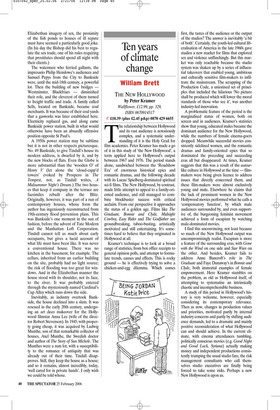Ten years of climate change
William Brett
THE NEW HOLLYWOOD by Peter Kramer Wallflower, £12.99, pp. 329, ISBN 0670914517 ✆ £10.39 (plus £2.45 p&p) 0870 429 6655 The relationship between Hollywood and its vast audience is notoriously complex, and a systematic understanding of it is the Holy Grail for film academics. Peter Kramer has made a go of it in this study of ‘the New Hollywood’, a term applied here to Hollywood’s output between 1967 and 1976. The period stands alone, sandwiched between the ‘Roadshow Era’ of enormous historical epics and romantic dramas, and the following decade with its Lucas/ Spielberg-dominated spiritual sci-fi films. The New Hollywood, by contrast, made little attempt to appeal to a family-oriented audience, and still managed to combine blockbuster success with critical acclaim. From our perspective it approaches the status of a golden age. Films like The Graduate, Bonnie and Clyde, Midnight Cowboy, Easy Rider and The Godfather are groundbreaking, taboo-busting, artistically motivated and still entertaining. It’s sometimes hard to believe that they originated in Hollywood at all.
Kramer’s technique is to look at a broad range of statistics, from box office receipts to general opinion polls, and attempt to formulate trends, causes and effects. This is rocky ground — he is effectively trying to solve a chicken-and-egg dilemma. Which comes first, the tastes of the audience or the output of the studios? The answer is inevitably ‘a bit of both’. Certainly, the youth-led cultural liberalisation of America in the late 1960s gave studios a new market for films that explored sex and violence unflinchingly. But this market was only reachable because the studio system was shaken up by a series of influential takeovers that enabled young, ambitious and culturally sensitive film-makers to infiltrate the mainstream. The scrapping of the Production Code, a unionised set of principles that included the hilarious ‘No picture shall be produced which will lower the moral standards of those who see it’, was another industry-led innovation.
A problematic feature of the period is the marginalised status of women, both on screen and in audiences. Kramer’s statistics show that young, educated males became the dominant audience for the New Hollywood, while the numbers of female cinema-goers dropped. Meanwhile successful movies consistently sidelined women, and the romantic dramas and family-oriented epics that so dominated the preceding and succeeding eras all but disappeared. At times, Kramer suggests that this was a result of the auteurlike culture in Hollywood at the time — filmmakers were being given licence to address issues that directly concerned them, and these film-makers were almost exclusively young and male. Elsewhere he claims that the lack of prominent women in the New Hollywood movies performed what he calls a ‘compensatory function’, by which male audiences surrounded by, and even supportive of, the burgeoning feminist movement achieved a form of escapism by watching male-dominated movies.
I find this unconvincing, not least because so much of the New Hollywood output was uncompromisingly realist. Escapism is more a feature of the surrounding eras, with Gone with the Wind on one side and Star Wars on the other. And besides, Kramer fails to address Anne Bancroft’s role in The Graduate and Faye Dunaway’s in Bonnie and Clyde, both immortal examples of female empowerment. Here Kramer stumbles on the problem, as old as Hollywood itself, of attempting to systematise an intrinsically chaotic and incomprehensible business.
A study of this period in Hollywood’s history is very welcome, however, especially considering its contemporary relevance. Then as now, changes in production values and priorities, motivated partly by internal industry concerns and partly by shifting audience demands, led to a dramatic and mainly positive reconsideration of what Hollywood can and should achieve. In the current climate, with cinema attendances tumbling, politically conscious movies (e.g. Good Night and Good Luck, Syriana) actually making money and independent productions consistently trumping the usual studio fare, the risk management consultants who call themselves studio executives are finally being forced to take some risks. Perhaps a new New Hollywood is upon us.


































































 Previous page
Previous page